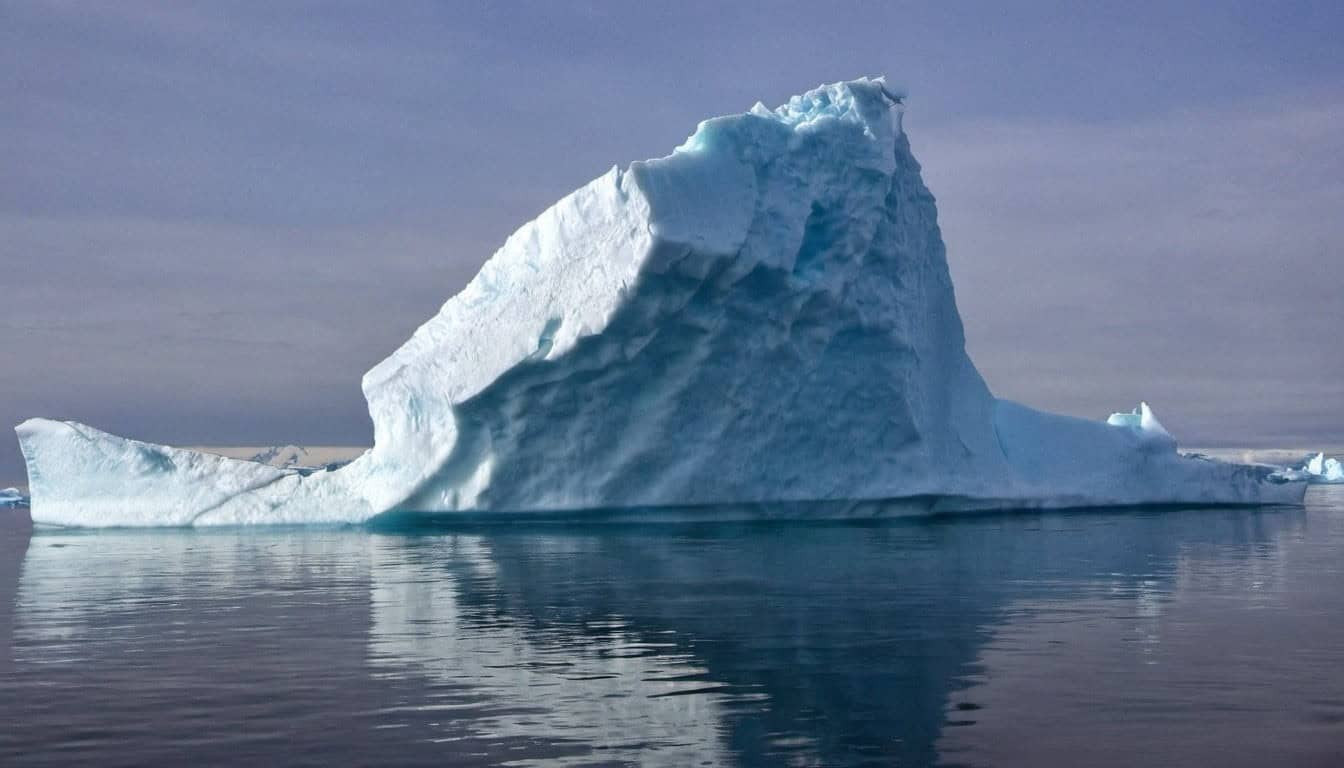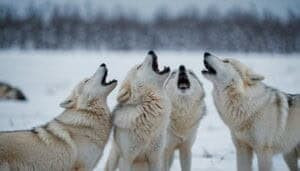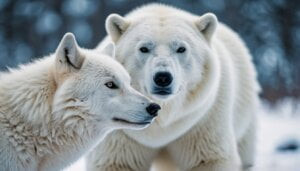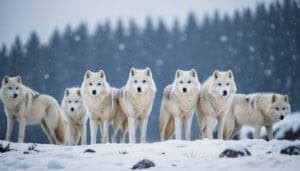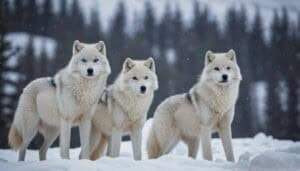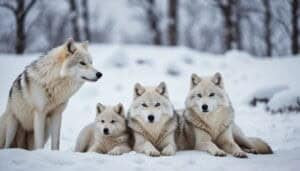Introduction
As the Arctic undergoes significant environmental changes, the loss of sea ice is becoming a critical issue for many species, including the Arctic wolf
This article explores how sea ice loss affects the movement patterns of Arctic wolves, impacting their survival and behavior. We will examine the primary factors contributing to sea ice loss, how Arctic wolves traditionally use sea ice, the immediate and long-term impacts on their behavior and populations, and their adaptations to the changing environment
Through this exploration, we aim to understand the challenges faced by Arctic wolves and the broader implications for the Arctic ecosystem
Factors Contributing to Sea Ice Loss in the Arctic
Climate Change and Global Warming
The primary driver of sea ice loss in the Arctic is climate change, largely due to global warming. Over the past century, human activities have significantly increased the concentration of greenhouse gases in the atmosphere, leading to a rise in global temperatures
The Arctic is warming at more than twice the global average, a phenomenon known as Arctic amplification. This rapid warming accelerates the melting of sea ice, creating a feedback loop where the loss of reflective ice surfaces leads to more heat absorption by the darker ocean, further increasing temperatures and ice melt
According to the National Snow and Ice Data Center (NSIDC), the extent of Arctic sea ice has declined by about 13% per decade since satellite measurements began in 1979. This drastic reduction is not just limited to the surface area; the thickness and volume of the ice are also decreasing, making the ice more susceptible to melting during the warmer months
This ongoing trend has profound implications for Arctic ecosystems, including the habitats and movement patterns of Arctic wolves
Natural Variability in Arctic Ice
While human-induced climate change is the dominant factor, natural variability also plays a role in sea ice dynamics
The Arctic climate system is inherently variable, with fluctuations in sea ice extent occurring due to natural cycles such as the Arctic Oscillation (AO) and the North Atlantic Oscillation (NAO). These atmospheric patterns influence wind and temperature conditions in the Arctic, contributing to year-to-year variability in sea ice coverage
For instance, positive phases of the AO are associated with stronger winds that can lead to greater ice drift and more ice being exported out of the Arctic through the Fram Strait. Conversely, negative phases may contribute to ice retention
Understanding these natural variations is crucial for distinguishing between short-term anomalies and long-term trends driven by climate change
Human Activities and Pollution
Beyond greenhouse gas emissions, other human activities and pollution also contribute to sea ice loss. Black carbon, or soot, is a significant pollutant resulting from incomplete combustion of fossil fuels, biomass, and wildfires
When black carbon settles on ice and snow, it reduces their albedo (reflectivity), causing them to absorb more sunlight and melt faster. The deposition of black carbon in the Arctic has been linked to increased melting rates of sea ice
Moreover, industrial activities such as oil and gas exploration, shipping, and fishing in the Arctic regions can physically disrupt sea ice. Icebreakers and other vessels create open water pathways, which can enhance melting and fragmentation of the ice
Increased human presence in these remote areas also raises the risk of oil spills and other environmental hazards that could further degrade sea ice and the broader Arctic environment
Traditional Use of Sea Ice by Arctic Wolves
Seasonal Migration Patterns
Arctic wolves (Canis lupus arctos) have evolved to thrive in one of the harshest environments on Earth. Traditionally, they rely heavily on sea ice for their seasonal migration patterns
During the winter months, when the sea ice is at its maximum extent, these wolves use the ice as a bridge to travel between islands and the mainland in search of prey. This mobility is crucial for accessing food resources that are otherwise separated by vast stretches of open water during the summer
The migration patterns of Arctic wolves are intricately tied to the life cycles of their primary prey, such as muskoxen and Arctic hares. The wolves follow these animals across the ice, exploiting their movements to ensure a steady food supply
Sea ice facilitates this dynamic, allowing wolves to cover large distances and maintain their pack structure, which is essential for hunting and survival
Hunting Strategies on Ice
Sea ice not only serves as a migration route but also as a vital hunting ground for Arctic wolves. The ice provides a stable platform from which they can stalk and ambush their prey
Wolves are highly adaptive hunters, and their strategies on the ice are a testament to their ingenuity and cooperation within packs. They utilize the vast, open landscapes of the ice to spot and track prey from a distance, coordinating attacks that maximize their chances of a successful kill
One notable hunting strategy involves using the ice to their advantage by herding prey into more confined spaces or towards the water’s edge, where the animals are less agile and more vulnerable
The ice can also act as a natural barrier, preventing prey from escaping and allowing wolves to corner them more effectively. These tactics highlight the critical role that sea ice plays in the hunting success of Arctic wolves
Denning and Breeding Practices
Denning and breeding are other aspects of Arctic wolf life that are influenced by the presence of sea ice. Wolves often establish dens on coastal islands and along the shores where the ice meets the land
These locations provide a secure environment for raising pups, away from potential predators and human disturbances. The proximity of these dens to sea ice is crucial, as it ensures that the wolves can easily access hunting grounds and maintain their nomadic lifestyle even while rearing young
The breeding season for Arctic wolves typically occurs during the late winter months, with pups being born in the spring. The timing coincides with the peak of sea ice extent, providing a relatively stable and secure environment for the vulnerable pups
As the ice begins to melt in the summer, the wolves and their growing pups gradually move inland, following the retreating ice edge and continuing their lifecycle in alignment with the changing seasons
Immediate Impacts of Sea Ice Loss on Arctic Wolf Behavior
Changes in Movement and Travel Routes
The rapid decline in sea ice has immediate and profound effects on the movement patterns of Arctic wolves. With traditional ice bridges between islands and the mainland disappearing, wolves are forced to alter their travel routes significantly
This disruption not only affects their ability to follow seasonal migration patterns but also limits their access to different hunting grounds, leading to potential food shortages
In response to these changes, Arctic wolves are increasingly forced to travel overland, which is more energetically costly and less efficient compared to traveling over ice. The need to traverse larger expanses of land can result in longer journeys and increased risk of encountering human activities, such as roads and settlements, which pose additional threats
These altered travel routes can also fragment wolf populations, isolating packs and reducing genetic diversity
Shifts in Hunting Behavior
As sea ice diminishes, Arctic wolves are compelled to adapt their hunting strategies to cope with the changing environment
The loss of stable ice platforms for stalking and ambushing prey means that wolves must rely more on land-based hunting, which presents different challenges and opportunities. On land, wolves might find it harder to track and corner prey, leading to decreased hunting success rates
Moreover, the availability of traditional prey like muskoxen and Arctic hares may decline as these species also struggle with habitat changes. Arctic wolves may have to expand their diet to include alternative food sources, such as marine mammals or carrion, which can impact their nutritional status and health
Additionally, shifts in prey populations and behavior could lead to increased competition with other predators, such as polar bears and foxes, further complicating the wolves’ ability to secure food
Alterations in Pack Dynamics
The social structure and dynamics of Arctic wolf packs are intricately linked to their environment and hunting success. Sea ice loss disrupts these dynamics by affecting the availability and distribution of prey, leading to potential changes in pack size and cohesion
When food is scarce, larger packs may struggle to find enough resources to sustain all members, resulting in increased competition within the pack and potential splitting of the group into smaller units
These alterations can weaken the pack’s overall hunting efficiency and success, as cooperative hunting is a key strategy for taking down larger prey. Additionally, changes in movement patterns and travel routes can separate pack members, challenging their ability to communicate and coordinate effectively
This disruption of social bonds can have cascading effects on the reproductive success and survival rates of the pack
Effects of Sea Ice Loss on Prey Availability
Decline in Prey Species
The loss of sea ice has a direct impact on the availability of prey species for Arctic wolves. Many of the wolves’ traditional prey, such as muskoxen and Arctic hares, depend on the sea ice environment for their survival and migration patterns
As sea ice diminishes, these prey species are forced to adapt to new habitats, which can lead to population declines and shifts in distribution
For instance, muskoxen, which are crucial for the wolves’ diet, are experiencing habitat loss and fragmentation due to the changing ice landscape. This can reduce their numbers and make them less accessible to wolves
Similarly, Arctic hares, which rely on the ice and snow-covered landscapes for camouflage and protection from predators, may face increased predation and decreased reproductive success as their habitat changes
Changes in Prey Migration Patterns
The seasonal migration patterns of prey species are also affected by the loss of sea ice. Prey that traditionally migrated across ice to breeding or feeding grounds may find these routes disrupted or entirely impassable. This forces them to find alternative pathways, often leading them further inland or into less suitable habitats
Arctic wolves, which have evolved to track and follow these migrations, must also adapt to these changes. The altered migration patterns can lead to mismatches in timing and location, making it more challenging for wolves to locate and hunt their prey. This can result in periods of food scarcity, impacting the health and survival of wolf packs
Increased Competition for Food
As prey species decline and their migration patterns change, Arctic wolves face increased competition for food
This competition is not only within the species but also with other predators in the region, such as polar bears and Arctic foxes. The reduction in sea ice forces these predators to overlap in their hunting territories more frequently, intensifying the struggle for limited resources
In areas where prey is particularly scarce, this heightened competition can lead to aggressive encounters between species and even within wolf packs. The stress of finding enough food can also result in changes in diet, with wolves resorting to scavenging more frequently or hunting smaller, less nutritious prey
These dietary changes can affect the overall health and reproductive success of Arctic wolves
Long-Term Effects on Arctic Wolf Populations
Population Decline and Fragmentation
The long-term effects of sea ice loss on Arctic wolf populations are concerning, with potential declines and fragmentation of packs. As their habitat becomes increasingly fragmented due to melting ice, wolves are forced into smaller, isolated areas
This isolation can lead to reduced genetic diversity, making populations more vulnerable to diseases and less adaptable to environmental changes
Population decline is also a significant risk. With the loss of traditional hunting grounds and prey species, wolves face food shortages that can lead to starvation, lower reproductive success, and higher mortality rates
Studies have shown that Arctic wolf populations are already experiencing stress from these changes, and the continued loss of sea ice could exacerbate these trends
Genetic Diversity and Health Issues
Genetic diversity is crucial for the health and resilience of any species. As Arctic wolf populations become more isolated due to habitat fragmentation, the gene pool shrinks, leading to inbreeding and a decrease in genetic diversity. This can result in a higher incidence of genetic disorders and reduced overall fitness of the population
Inbreeding can also lead to a decrease in the ability of the wolves to adapt to new challenges, such as diseases or further environmental changes. This reduced adaptability can make it more difficult for the population to recover from other stressors, further threatening their long-term survival
Adaptation and Evolutionary Changes
Despite these challenges, Arctic wolves are known for their adaptability. Over time, they may exhibit evolutionary changes in response to the changing environment
For example, they might develop new hunting strategies or dietary preferences to cope with the reduced availability of traditional prey. These adaptations could help them survive in a landscape increasingly dominated by open water and fragmented ice
However, the rate of environmental change in the Arctic is unprecedented, and it is uncertain whether Arctic wolves can adapt quickly enough to keep pace with these changes. The evolutionary process is slow, and the rapid loss of sea ice may outstrip the wolves’ ability to adapt, leading to further population declines
Adaptations and Responses to Diminishing Sea Ice
Changes in Diet and Hunting Techniques
As sea ice continues to diminish, Arctic wolves are forced to adapt their diet and hunting techniques to cope with the changing environment. Traditionally reliant on prey like muskoxen and Arctic hares, wolves are now diversifying their diets to include marine mammals, such as seals and even fish, when accessible
This dietary shift is driven by the need to find alternative food sources as traditional prey becomes less available or harder to access due to changes in ice coverage
Hunting techniques are also evolving. On land, wolves must adapt to different terrains and prey behavior, leading to the development of new hunting strategies. For instance, wolves might employ more opportunistic hunting tactics, targeting weaker or isolated individuals, and increasing their reliance on scavenging. These changes highlight the wolves’ resilience and ability to innovate in response to environmental stressors
Increased Land-Based Movement
With the reduction of sea ice, Arctic wolves are spending more time on land. This shift in habitat use necessitates adjustments in their movement patterns and territorial ranges. Wolves are now traveling greater distances overland to find food, which can lead to increased energy expenditure and exposure to new risks, such as human activities and altered predator-prey dynamics
Land-based movement also means that wolves may encounter different species and ecosystems, requiring them to navigate new social and environmental challenges. The expanded territory can lead to interactions with other predators, such as grizzly bears, and increased competition for resources. This adaptation is crucial for their survival, but it also brings a host of new challenges that the wolves must overcome
Interaction with Human Habitats
As Arctic wolves venture further inland and closer to human settlements, interactions with humans become more frequent
This proximity can lead to conflicts, as wolves may prey on livestock or scavenge near communities. Such interactions can result in negative outcomes for wolves, including increased mortality due to retaliatory killings or accidents
Human presence can also disrupt wolf behavior and movement patterns. Wolves may alter their routes to avoid areas with high human activity, which can further fragment their habitat and reduce their access to resources
Conversely, some wolves may become habituated to human presence, leading to bolder behavior and potential safety risks for both wolves and humans
Conservation and Mitigation Efforts
In response to these challenges, conservation efforts are essential to support Arctic wolf populations. Protecting critical habitats, implementing wildlife corridors, and reducing human-wolf conflicts are vital strategies. Conservation organizations and researchers are also monitoring wolf populations to understand their adaptive behaviors and inform management practices
Mitigation efforts aimed at addressing climate change, such as reducing greenhouse gas emissions and protecting sea ice, are crucial for the long-term survival of Arctic wolves. By preserving the ice and the ecosystems it supports, we can help maintain the natural balance that Arctic wolves rely on
Conclusion
The loss of sea ice in the Arctic has profound implications for the movement patterns and survival of Arctic wolves
These apex predators, traditionally reliant on sea ice for migration, hunting, and breeding, face significant challenges as their environment changes. Factors such as climate change, natural variability, and human activities contribute to the rapid decline of sea ice, disrupting the wolves’ traditional behaviors
Arctic wolves are forced to adapt to this new reality by altering their movement routes, hunting techniques, and social dynamics. The reduction in prey availability, changes in prey migration patterns, and increased competition for food further complicate their survival. Long-term effects include population decline, genetic diversity issues, and the necessity for rapid evolutionary adaptations
Despite these challenges, Arctic wolves demonstrate remarkable resilience and adaptability. They are diversifying their diets, adjusting hunting strategies, and navigating increased land-based movement
However, their survival depends heavily on effective conservation and mitigation efforts aimed at protecting critical habitats, reducing human-wolf conflicts, and addressing the root causes of climate change
The future of Arctic wolves is intricately tied to the health of the Arctic ecosystem. By understanding the impacts of sea ice loss and supporting conservation initiatives, we can help ensure the continued existence of these magnificent predators in their rapidly changing environment
